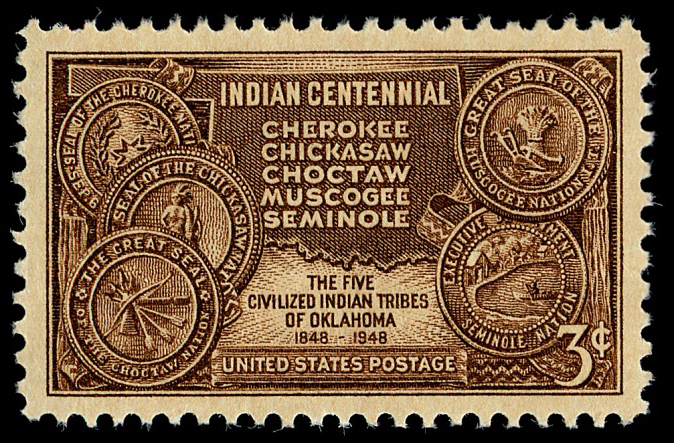
On October 14-15, 1948, Native Americans of the Five Civilized Tribes of Oklahoma - Cherokee, Chickasaw, Choctaw, Muscogee and Seminole - would gather in Muskogee, Oklahoma to commemorate the centennial of their forced move [the Trail of Tears] by the United States government from their tribal lands on the East Coast to Indian Territory [later Oklahoma].
Elmer Thomas, U. S. Senator from Oklahoma, wrote to Postmaster General Hannegan on October 8, 1947 forwarding a request for a commemorative stamp to honor the Five Civilized Indian Tribes residing in Oklahoma. Sequoyah was the recommended subject. "Oklahoma is the home of almost one-half of the entire Indian population of the nation and, as such, the Indian citizens of our state play a most important part in both the economic and political life of Oklahoma."
In November his colleague, Congressman Stigler, also submitted a request citing "that at no time has our government commemorated the American Indian except by placing an Indian head on the regular 14-cent postage stamp [not a commemorative stamp]." "The background behind this movement is that in 1838 the trail of Tears was started and in 1848, ten years later, all the Five Civilized Tribes were moved by force to the Indian Territory which is now Oklahoma."
Hannegan's response was positive and cited official interest in observing "the centennial of the transfer of the Five Civilized Tribes to the Indian country…" As regards Sequoyah as the subject for the stamp, Hannegan admitted that "There has been considerable support…for some years" for a stamp to honor "the great Chief" but an appropriate opportunity has never come.
By January 30, 1948, C. N. A. DeBajligethy, chairman of the Indian Centennial, was contacting Roy North, Deputy Third Asst. Postmaster General, to offer further impetus to issue this stamp saying, "…if you will do your utmost to get this stamp released, I will with the assistance of various organizations throughout the State, see that all past stamp sale records are broken…". And he adds that "…this stamp would be issued near election time and will mean a whole lot to the Democratic Party…well over 100,000 people [will attend the centennial] and naturally political plans will be made…"
Joint resolutions introduced in February and April 1948 by Sen. Thomas and Rep. Stigler were approved and the Postmaster General was "authorized and directed to issue a special [3-cent] postage stamp bearing the likeness of the great seals of the Five Civilized Tribes" to be "placed on sale in Muskogee, Oklahoma, one day before it is made available to the public elsewhere."
But by April 23, 1948, the stamp issuance was put in jeopardy by the protests of "some Indians" who were asking Pres. Truman to veto the bill because of misunderstandings concerning the Centennial. Mr. DeBajligethy wrote William Zimmerman, Jr., Acting Commissioner of the Office of Indian Affairs, begging him to intercede with the President. The Centennial and stamp were not meant to celebrate the tragic relocation of the Native Americans but to honor "their remarkable progress and achievements."
"Mr. Zimmerman, the expression 'trail of tears' has no place in the Indian Centennial Celebration." "This Indian Centennial is celebrating and honoring our Indian Citizens today known as 'the Five Civilized Tribes' in every State of the Union, the Cherokees, Choctaws, Creeks, Chickasaws and Seminoles for the following reason: In 1848 the first meeting or council was held by all of the five mentioned tribes, which became known as he Union of the Five Tribes, from this point 1848 to 1948, the members of these five tribes have made a 'March of Progress' that contributed to the attainment of Statehood and in this period of time they have distinguished themselves by giving to the Nation many men of high distinction in arts, letters, government and professional fields."
By May preparations were back on track. The Director of the Bureau of Engraving and Printing was sent "photostat reproductions of the Five Great Seals of the Five Civilized Tribes of Oklahoma, which we are required by legislation to employ in the design…" Four models were produced by the Bureau for the Post Office Department's approval. Finally on September 13 - just a month before the celebration - Postmaster General Jesse Donaldson announced the issuance of the 3-cent brown, horizontal stamp.
dimensions: 0.84 by 1.44 inches
denomination: 3-cent
color: brown
